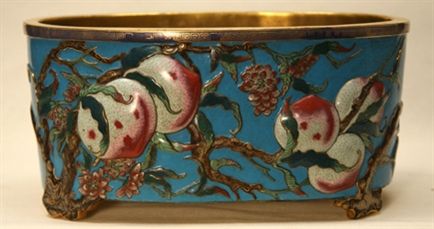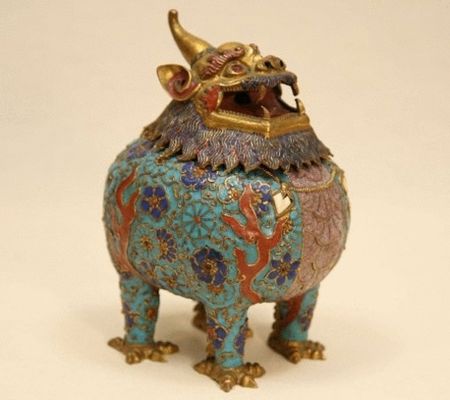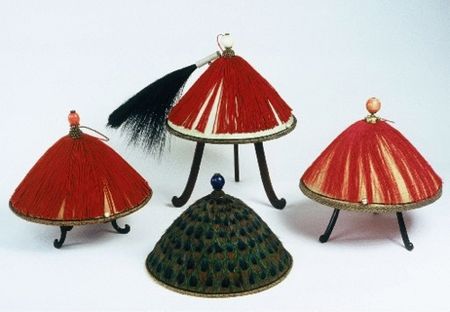"ELEGANCE OF THE QING COURT: Reflections of a Dynasty Through Its Art" au Joslyn Art Museum, Nebraska
J'ai eu le plaisir de rencontrer John Fong à Boston, au cocktail donné par Steven et Loïs Kunian. Nous avons longuement bavardé et sympathisé et John a promis de m'envoyer le catalogue de l'exposition.
Imperial dragon roundel for a prince (detail), 1730, embroidery with couched gold thread mounted on a dark blue silk, Private Collection
The Qing (pronounced Ching) dynasty in China began in 1664, after the Manchu overthrow of the Han Ming empire and with the ascension to the throne of seven-year-old Emperor Kangxi. It endured for more than 250 years, until 1911, when revolt led to the establishment of the Republic of China (now, the People's Republic of China). During this period, an empire which, at its height, possessed technology, art, and grandeur beyond imagination, descended into a land of chaos, poverty, and internal revolt. This dramatic rise and fall is reflected in the art of the period.
During the reigns of the three great Qing emperors, Kangxi, Yongzheng, and Qianlong – a time of great wealth and relative peace – imperial workshops proliferated and produced arts and crafts not only of superb quality but also in great quantity. Such productivity and creativity was highly influenced by the personal interest of the emperors themselves. The arts in China flourished at a height never again to be matched.
The exhibition spans the entire dynasty, presenting over 200 porcelain, metal, lacquer, textile, ivory, and jade objects, some produced under the supervision of the court and in the imperial workshops. The objects, many created for the court or its officials, offer visitors the opportunity to experience the magnificence of Qing creativity at its finest, contrasted by items produced for commerce as the dynasty drew to a close. Included are examples of porcelain from the imperial kilns at Jingdezhen, with their remarkable glazes and enameling; textiles demonstrating court dress; furniture from the Summer Palace; and smaller objects, such as belt buckles and abstinence plaques. A highlight is the 18th-century, eight-panel, carved red lacquer screen recently acquired by Joslyn Art Museum, which will, for the first time, be placed in the context of Qing dynasty decorative arts.
The exhibition is organized for Joslyn by Dr. John Fong, Adjunct Curator of Asian Art, and will be accompanied by the publication Elegance of the Qing Court: Reflections of a Dynasty Through Its Art, also by Dr. Fong.
Imperial nine-peach jardinière (Qianlong period, 1735–1796), cloisonné and champlevé enamel on metal, Collection of Drs. John K. Fong and Colin Johnstone
Manchu lady's shoes, Tongzhi period (1862-1874), embroidered, Private Collection
An enameled censer is among the objects in the Joslyn's new exhibit.
The Joslyn's exhibit includes summer hats.

/https%3A%2F%2Fprofilepics.canalblog.com%2Fprofilepics%2F1%2F0%2F100183.jpg)
/https%3A%2F%2Fstorage.canalblog.com%2F03%2F02%2F119589%2F96711876_o.jpg)
/https%3A%2F%2Fstorage.canalblog.com%2F11%2F31%2F119589%2F94773502_o.jpg)
/https%3A%2F%2Fstorage.canalblog.com%2F20%2F83%2F119589%2F94772815_o.jpg)
/https%3A%2F%2Fstorage.canalblog.com%2F26%2F72%2F119589%2F75604929_o.jpg)
/https%3A%2F%2Fstorage.canalblog.com%2F59%2F60%2F119589%2F26458628_o.jpg)







/image%2F1371349%2F20240429%2Fob_a32180_438086347-1659660838137262-66806538687.jpg)
/image%2F1371349%2F20240429%2Fob_5853a1_440937185-1660184551418224-14760604465.jpg)
/image%2F1371349%2F20240428%2Fob_096a92_telechargement-10.jpg)
/image%2F1371349%2F20240428%2Fob_d84f93_telechargement-8.jpg)